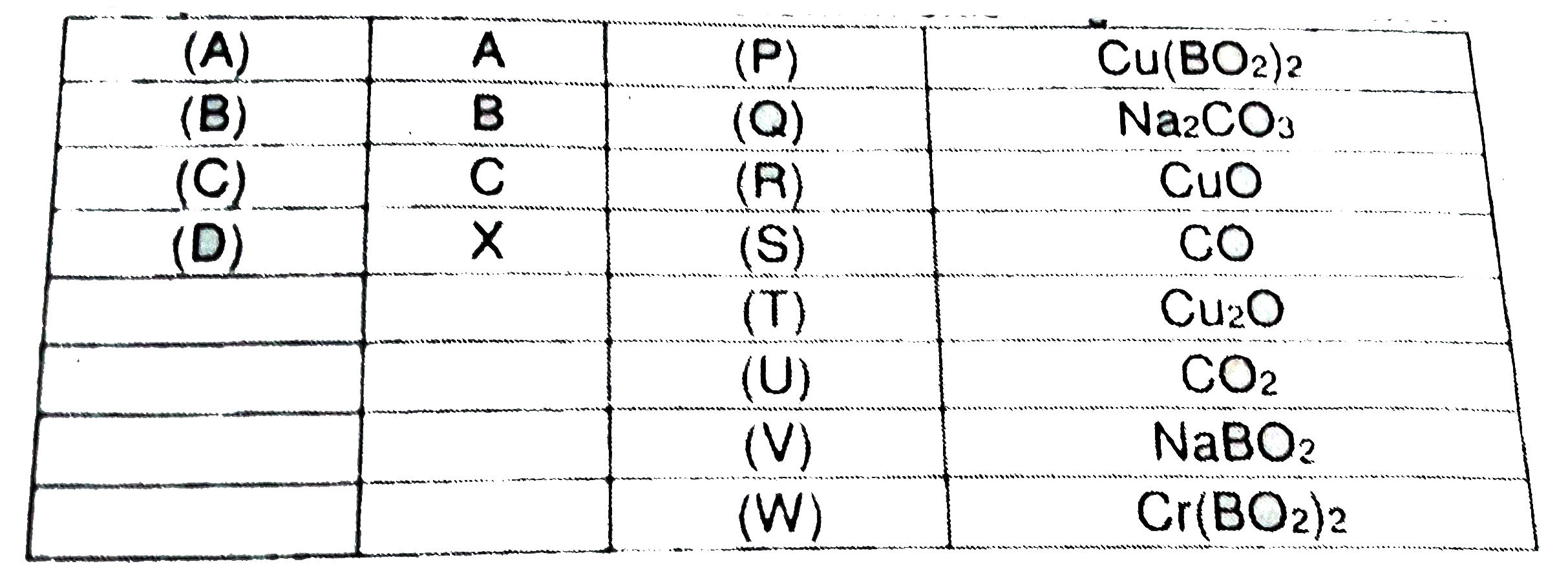CO2 gas along with solid (Y) is obtained when sodium salt (X) is heated. (X) is again obtained when CO2 has is passed into (Y). X & Y are-
Na2CO3,Na2O
Na2CO3,NaOH
NaHCO3,Na2CO3
Na2CO3,NaHCO3
The correct Answer is:C
To solve the problem, we need to identify the sodium salt (X) and the solid (Y) based on the given reactions involving CO₂ gas.
1. Identify the Sodium Salt (X):
- We are told that when sodium salt (X) is heated, it produces a solid (Y) and CO₂ gas.
- The possible candidates for sodium salts from the options are: Na₂CO₃, NaOH, NaHCO₃, and Na₂O.
2. Heating Sodium Bicarbonate (NaHCO₃):
- When sodium bicarbonate (NaHCO₃) is heated, it decomposes to form sodium carbonate (Na₂CO₃), water (H₂O), and carbon dioxide (CO₂).
- The reaction can be written as:
2NaHCO3(s)→Na2CO3(s)+H2O(g)+CO2(g)
- Thus, when heated, NaHCO₃ produces Na₂CO₃ (solid Y) and CO₂ gas.
3. Identify the Solid (Y):
- From the above reaction, we can conclude that solid (Y) is sodium carbonate (Na₂CO₃).
4. Reversing the Reaction:
- The question states that when CO₂ gas is passed into solid (Y), we obtain sodium salt (X) again.
- When CO₂ is bubbled through Na₂CO₃ (solid Y), it reacts with water to form sodium bicarbonate (NaHCO₃):
Na2CO3(s)+CO2(g)+H2O(l)→2NaHCO3(s)
- This confirms that when CO₂ is passed into Na₂CO₃, we regenerate NaHCO₃ (sodium bicarbonate), which is our sodium salt (X).
5. Final Conclusion:
- Therefore, we conclude that:
- Sodium salt (X) = NaHCO₃
- Solid (Y) = Na₂CO₃
Final Answer:
- X=NaHCO3 (sodium bicarbonate)
- Y=Na2CO3 (sodium carbonate)
- We are told that when sodium salt (X) is heated, it produces a solid (Y) and CO₂ gas.
- The possible candidates for sodium salts from the options are: Na₂CO₃, NaOH, NaHCO₃, and Na₂O.
- When sodium bicarbonate (NaHCO₃) is heated, it decomposes to form sodium carbonate (Na₂CO₃), water (H₂O), and carbon dioxide (CO₂).
- The reaction can be written as:
2NaHCO3(s)→Na2CO3(s)+H2O(g)+CO2(g)
- Thus, when heated, NaHCO₃ produces Na₂CO₃ (solid Y) and CO₂ gas.
- From the above reaction, we can conclude that solid (Y) is sodium carbonate (Na₂CO₃).
- The question states that when CO₂ gas is passed into solid (Y), we obtain sodium salt (X) again.
- When CO₂ is bubbled through Na₂CO₃ (solid Y), it reacts with water to form sodium bicarbonate (NaHCO₃):
Na2CO3(s)+CO2(g)+H2O(l)→2NaHCO3(s)
- This confirms that when CO₂ is passed into Na₂CO₃, we regenerate NaHCO₃ (sodium bicarbonate), which is our sodium salt (X).
- Therefore, we conclude that:
- Sodium salt (X) = NaHCO₃
- Solid (Y) = Na₂CO₃
- X=NaHCO3 (sodium bicarbonate)
- Y=Na2CO3 (sodium carbonate)
Topper's Solved these Questions
- BOOK - ALLENCHAPTER - S-BLOCK ELEMENTS EXERCISE - EXERCISE -1 (B)1videos
S-BLOCK ELEMENTS
- BOOK - ALLENCHAPTER - S-BLOCK ELEMENTS EXERCISE - EXERCISE -21videos
S-BLOCK ELEMENTS
- BOOK - ALLENCHAPTER - S-BLOCK ELEMENTS EXERCISE - EXERCISE -31videos
S-BLOCK ELEMENTS
- BOOK - ALLENCHAPTER - s-Block element EXERCISE - All Questions14videos
s-Block element
- BOOK - ALLENCHAPTER - SOLUTIONSEXERCISE - EXERCISE -05 [B]22videos
SOLUTIONS
Similar Questions
Knowledge Check
- Question 1 - Select One
A certain compound X impats golden yellow flame. Whenzinc powder is heated with concenrated solution of X, H2 gas is evolved. X combines with CO2 to give a salt Y. Y is a hydrated salt which on reaction with HCl or ecess of CO2 gives another salt Z which is an important part of baking powder. identify X, Y and Z.
AX−NaOH,Y−Na2CO3,Z−NaHCO3BX−HCl,Y−NaOH,Z−NaHCO3CX−KOH,Y−K2CO3,Z−KHCO3DX−NaCl,Y−Na2CO3,Z−NaOH - Question 2 - Select One
A gas (X) is obtained when copper reacts with dilute HNO3. The gas thus formed reacts with oxygen to give brown fumes of (Y). (Y) when dissolved in water gives an important acid (Z) and the gas (X). X, Y and Z respectively are
ANO,NO2,HNO3BNO2,NO,HNO3CN2O,NO,HNO2DNO,N2O,HNO3 - Question 3 - Select One
A white solid X on heating gives a white solid Y and an acid gas Z. gas Z is also given out when X reacts with an acid. The compound Y is also formed if caustic soda is left open in the atmosphere. X, Y and Z are
AX−NaHCO3,Y−Na2CO3,Z−CO2BX−Na2CO3,Y−NaOH,Z−CO2CX−Na2CO3,Y−NaHCO3,Z−CO2DX−NaOH,Y−NaHCO3,Z−CO2
CO2 cannot be obtained by heating
View SolutionA solid compound 'X' on heating gives CO2 gas and a residue. The residue mixed with water forms 'Y'. On passing an excess of CO2 through 'Y' in water , a clear solution, 'Z' is obtained. On boiling 'Z', compound 'X' is reformed. The compound 'X' is
View SolutionA solid compound 'X' on heating gives CO2 gas and a residue. The residue mixed with water forms 'Y'. On passing an excess of CO2 through 'Y' in water , a clear solution, 'Z' is obtained. On boiling 'Z', compound 'X' is reformed. The compound 'X' is
View SolutionCuCO3 was strongly heated to obtain a residue A and gas B. The residue obtained was treated with a salt of sodium 'X' and oxide Y, which produced a blue colored glassy compound C on heating in oxidising flame. The same combination of x and Y gave a green colored glassy compound D when Cr2(SO4)3 was heated with them in oxidizing flame. Match the following accordingly :
 View Solution
View SolutionA metal X reacts with aqueous NaOH solution to form Y and a highly inflammalbe gas. Solution Y is heated and CO2 is poured through it. Z precipitates out and Na2CO3 is formed. Z on the heating gives AI2O3. Identify X,Y and Z.
X Y ZView Solution

